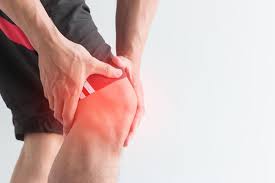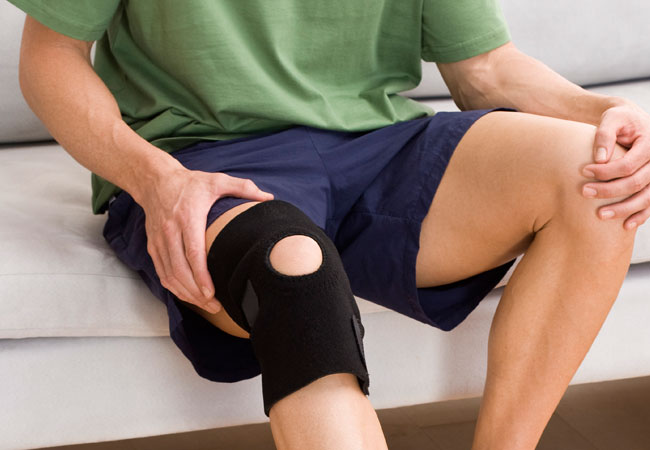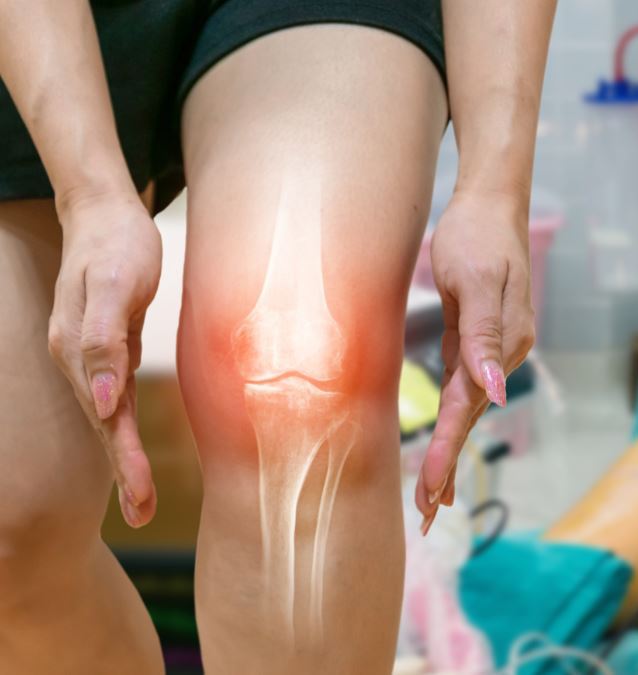Knee Pain is a common complaint that affects people of all ages. This could instigate in any of the bony structures consisting of the knee joint (femur, tibia, and fibula), the kneecap (patella), or the ligaments, tendons, and cartilage (meniscus).
Knee pain can be caused by an injury like ruptured ligament or torn cartilage or any medical conditions like arthritis, gout and infections.
Knee pain could be aggravated due to physical activity, obesity, affected by neighboring muscles and their movements, and could be triggered by other problems like foot injury. Knee pain causes physical restrictions.
The treatment of knee pain would depend on the underlying cause and severity of the pain. Prognosis of knee pain is usually good and the recovery might require medical treatment, surgery or other interventions.

SYMPTOMS OF KNEE PAIN
Pain in the knee would depend on the structure of the knee that is affected. In case of infection or an inflammatory process it could cause swelling and pain to the whole knee, whereas; a torn meniscus or fracture of a bone would have symptoms in a specific location or a baker cyst would cause pain in the back of the knee.
The severity of the knee pain could vary from minor ache to a severe and disabling pain. The symptoms along with pain could be:
- Difficulty in bearing weight or walking because of instability of the knee
- Limping caused by discomfort,
- Difficulty while walking due to ligament damage or sprain,
- Unable to bend the knee or locking of the knee,
- Redness and warmth on touching the knee
- Swelling and stiffness of knee
- Inability to extend the knee, and
- Shifting the weight to opposite knee and foot
- Popping or crunching noises from the knee

CAUSE OF KNEE PAIN
Some of the common knee problems are sprained ligaments, meniscus tears, tendinitis, and runner’s knee. Some of the causes of knee pain are:
- Bursitis – It is also known as prepatellar bursitis or preacher’s knee. A sac known as bursa holds a small amount of fluid present under the skin above the joint. This fluid helps in preventing friction when the joint moves. Bursa could be irritated on the top of the kneecap due to overuse, falls, or repeated bending and kneeling, which lead to pain and swelling.
- Patellar Dislocation – The kneecap sometimes slides out of position leading to knee pain and swelling.
- Meniscal tear – An injury could cause the cartilage to rip. The rough edges caused due to injury can get stuck in the joint causing pain and swelling.
- Osteoarthritis – The degeneration and deterioration of the joint causes pain, inflammation, and joint destruction. It majorly affects people above the age of 50.
- Patellar tendinitis – Pain and inflammation is caused in the tendon that connects the kneecap to the shinbone. Tendons are tough bands of tissue connecting the muscles to the bones. Overdoing the exercise causes inflamed and sore tendons.
- Osgood-Schlatter disease – An irritation below the knee a point where the tendon from the kneecap connects to the shin known as tibial tubercle. This causes inflammation and pain.
- Sprained or strained knee ligaments or muscles – This is usually caused due to a blow to the knee or a sudden twist of the knee causing inflammation or leading to difficulty in daily activities like walking.
Overweight as well as overuse due to repetitive motions create stress on the knee joint leading to knee pain. Due to change in the movement of the joint like leg-length difference, alteration in walking style because of back problems cause subtle changes leading to pain and injuries.
DIAGNOSIS OF KNEE PAIN
The doctor would begin the examination by bending the knee to check the full range of motion, check for stability of the muscles and ligaments, and evaluate to know any tenderness and swelling. Doctors would recommend blood tests, X-rays, CT scan or MRI, and other imaging tests to check for reasons for chronic pain.

TREATMENT OF KNEE PAIN
The treatment for knee pain depends on the cause and extent of pain. The treatment regime would comprise of following:
Medications – Both over-the-counter (OTC) and prescription drugs are used to manage knee pain depending on the severity of the pain. OTC medicines provide relief in mild to moderate pain. For severe pain doctors would prescribe stronger painkillers. Ointment either cream or gel based containing diclofenac (1%, 1.5%, or 2%) would help in reducing pain. Pain patches like lidocaine act like a local anesthetic agent that helps relieve pain by blocking nerves from transmitting pain signals to the brain.
Injection – Doctor would recommend injecting chemicals like corticosteroids, hyaluronic acid or lidocaine help in reducing the inflammation and eases the pain within a few weeks to months. Hyaluronic acid is a gel based substance occurring naturally in synovial fluid that acts like a lubricant which allows bones to move smoothly within a joint as well as provides shock absorption that decreases pressure and friction within joints.
Botox or Botulinum toxin is helpful in treating knee osteoarthritis as they paralyze the nerves that send chronic pain signals to the brain. Platelet-rich plasma injections stimulate the healing process after injury as they are made up of your own blood plasma containing high concentration of platelets called thrombocytes.
Therapy – Exercise helps in strengthening the muscles around your knee which will make it more stable. Exercises also improve your flexibility and balance to provide relief in activities like walking, swimming, water aerobics, stationary cycling, and elliptical machines. Physiotherapy also involves arch support or braces help in providing support and protecting the knee joint. Tai chi would help ease stiffness and improve balance.
RICE therapy (Rest, ice, compression and elevation) – It is beneficial in pain caused by minor injury or arthritis flare. It provides rest to the knee; application of ice reduces swelling and ease off the pain.
Surgery – Surgery is required based on injury. It might also be required if the other treatments do not provide relief. The options of surgery are;
Arthroscopic surgery – This depends on the type of injury that involves examination and repair of the joint damage using a fiber-optic camera. A long, narrow tool is inserted through a small incision around your knee. Arthroscopy is useful to remove loose bodies from the knee joint, remove or repair damaged cartilage, and reconstruct torn ligaments.
Partial Knee Replacement – This would involve replacing the damaged portion of your knee with parts made of metal and plastic.
Total Knee Replacement – This involves replacing the damaged bone and cartilage from the thigh bone, shinbone and kneecap with an artificial joint that is made of metal alloys, high-grade plastics and polymers.
Osteotomy – The surgery involves removing bone from the thigh bone or shinbone to allow better alignment of the knee that relieves arthritis pain.
Acupuncture, glucosamine and chondroitin supplements have proven to provide mixed results in treating knee pain.
OUTLOOK
Chronic knee pain treatment involves accurate evaluation to avoid further damage to cartilage, bones, or ligaments. With the help of modern surgical techniques it is possible to relieve various types of knee pain syndromes and return to an active lifestyle.
If you or anyone you know is suffering from knee pain, our expert providers at Specialty Care Clinics will take care of your health and help you recover.
Call us on 469-545-9983 to book an appointment with Dr. Raymond Fulp.
